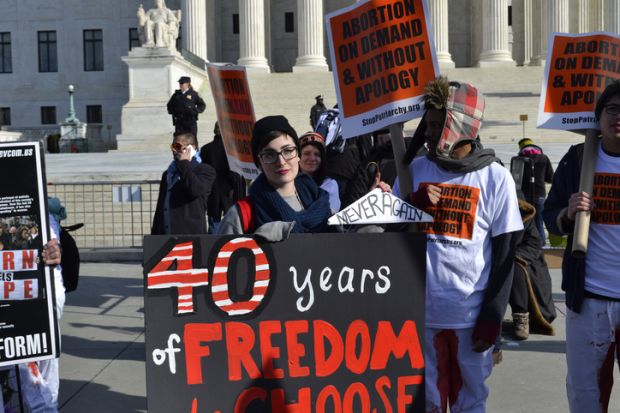Tens of thousands of women could have their university careers disrupted because of the US Supreme Court’s decision to end a half-century of legalised abortion nationwide, researchers have warned.
Ilana Horwitz, an assistant professor of Jewish studies and sociology at Tulane University who explores the interplay of religion and education, worked with her research team to estimate the number of women likely to have their college careers interrupted as a result of the ruling, taking into account data in areas that include rates of college attendance, family incomes and frequencies of unintended pregnancies.
They estimated that disruptions await some 180,000 of the roughly 20 million students attending college in the US, almost all of them low-income women who would face great difficulty in travelling to a state where abortion will remain legal.
Low-income women have proven unusually determined and resilient over the years in terms of resuming their college careers after disruptions, Dr Horwitz said. But they are also in a moment of exceptionally difficult circumstances because of the Covid pandemic, as they often end up becoming primary caregivers in their families, she said.
“This is another blow to women’s advancement in education and labour markets,” Dr Horwitz said.
The Supreme Court ruling has left colleges and universities guessing which states will now take the opportunity to outlaw abortion, under what conditions, and what might be the best institutional response. It has previously been suggested that about half of all US states are likely to restrict access to terminations, and that scholars and students might increasingly choose to avoid working and studying in their colleges.
Nevertheless, the ruling arrived with relatively little analysis and preparation evident among universities.
One of the few major institutions to offer its students and staff a preliminary assessment, the University of California system, promised that it would continue to provide a “full range of healthcare options” to its campus communities.
But many other institutions and their leaders – especially across the broad middle part of the US where new abortion restrictions seemed likely to come, if not already in effect – offered no immediate guidance.
The main lobby group for US higher education, the American Council on Education, had no response to the Supreme Court ruling.
The limited pushback by institutions appeared to reflect the political risks of abortion politics in many conservative-led states, said Dr Horwitz.
Yet the hesitancy also suggests a basic lack of public awareness of the depth of the connection between educational attainment and reproductive rights, she said.
“The idea of the motherhood penalty beginning in college is a new idea,” said Dr Horwitz, author of God, Grades, and Graduation: Religion’s Surprising Impact on Academic Success. “It’s not something people really have talked about.”
One of the more important battles yet to be fought in the aftermath of the Supreme Court ruling involves the use of pharmaceuticals to end pregnancies, which could sidestep place-based restrictions. Most abortions in the US now involve pills, up from two-fifths of them five years ago. That is expected to produce a showdown between at least 13 states that are now banning the drugs used for abortion, and the Biden administration, which has insisted that federal health authorities have the right to determine what medications are legal.
Register to continue
Why register?
- Registration is free and only takes a moment
- Once registered, you can read 3 articles a month
- Sign up for our newsletter
Subscribe
Or subscribe for unlimited access to:
- Unlimited access to news, views, insights & reviews
- Digital editions
- Digital access to THE’s university and college rankings analysis
Already registered or a current subscriber? Login








